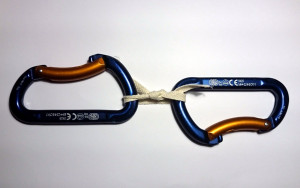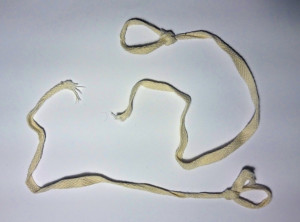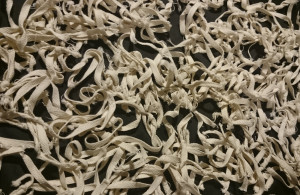I just got a new roll of 80lbs breakcord and I tried to figure out if temperature and humidity had some effect on its breaking strength. I’m talking about the standard 80lbs cotton break tape (MIL-T-5661) that we use for staticline jumps, and which you can get from paragear on a roll or in smaller amounts form your favorite base gear manufacturer.
For the pull tests I used 25cm pieces of breakcord, tied to a loop with a surgeons knot and attached in between two climbing carabiners for measuring. I did ten pull tests for each “treatment”, except the reference, that was done 20 times.
The test setup was pretty rudimentary, and since I don’t own a calibrated scale the absolute numbers are maybe off by a bit, but for comparing differently treated breakcord on the same setup it was sufficiently accurate, and the standard deviation showed to be not that big for each test set. (see table)
In each batch there was quite some variation, I suppose most of it is due to the knot and possible twists in the breakcord, in the reference batch for example I got values as low as 64kg and as high as 70kg, however the change in breaking strength for some “treatments” were way beyond that range and consistent.
- Reference
Straight off the roll and pull tested, no special treatment. - Wet
Soaked in water, pull tested wet. - Wet then dried
Soaked in water, then let dry for 24 hours. - Frozen
Put in the freezer for 12 hours, pull tested within 5 minutes of taking it out of the freezer. - Frozen wet
Soaked in water and put in the freezer for 12 hours, pull tested frozen. - 1h at 100°C
One hour in the oven at 100°C, pull tested within 5 minutes of taking it out of the oven. - 1h at 100°C then cool down
One hour in the oven at 100°C, left at room temperature for 24 hours before pull testing. - 1h at 50°C
One hour in the oven at 50°C, pull tested within 5 minutes of taking it out of the oven.
| Average breaking strength (kg) | % of reference | std. Deviation (kg) | % deviation | |
| Reference | 66.2 | 100.0% | 2.1 | 3.1% |
| Wet | 77.9 | 117.7% | 2.3 | 2.9% |
| Wet then dried | 66.4 | 100.3% | 3.9 | 5.9% |
| Frozen | 65.6 | 99.1% | 3.4 | 5.2% |
| Frozen wet | 77.0 | 116.3% | 2.6 | 3.4% |
| 1h at 100°C | 41.7 | 63.0% | 4.8 | 11.4% |
| 1h at 100°C then cool down | 63.0 | 95.2% | 4.5 | 7.1% |
| 1h at 50°C | 50.7 | 76.6% | 3.7 | 7.4% |
Findings
I was surprised that the soaked wet breakcord was significantly stronger than the reference, after testing that batch I read up that cotton is actually getting stronger when it is more humid, or even soaking wet. Sub 0°C temperature had pretty much no effect, while exposure to high temperatures showed a big decrease in breaking strength, which reversed after storing it at room temperature for some time again.
I suspect the reduction in breaking strength after exposure to higher temperatures in my kitchen oven are partially due to drying the breakcord further, reducing the water content in the cotton fibers compared to the reference batch. Since at the time I pull tested the last of those batches, the breakcords didn’t feel warm anymore but still had significantly reduced breaking strength. If I can come up with a better test setup to verify this I will update this article. (I’m happy to hear any suggestions)
Additionally to the tests above, I tried to find out if the breaking strength of a piece of cord changes when it is loaded to the limit multiple times. To do so I started off with multiple 1.50m pieces of breakcord and knots on both ends, breaking the single strand of cord again and again.
I could not measure any difference in breaking strength, even after pulling a piece of cord to breaking load for the 5th or 6th time. However, from the 3rd time breaking the same piece of cord on, some started breaking somewhere in the middle, and not at the knots anymore.
Something is going on there, although hard to measure. It seems that a piece of breakcord is actually damaged/weakened at random spots along its length, if it has been brought close enough to its breaking strength before. This could theoretically become a problem if this invisible weak spot would line up with a stress point at the knot at its next use, adding up the reductions in breaking strength.
To sum this up
- Store your breakcord properly.
- Cut pieces as you need them instead of trying to somehow rip them.
- Don’t reuse breakcord that has been loaded already.
- Don’t put it in your oven before using it.




Awesome test man! I did alot of bench pull tests before trusting mine too, however you were alot more thorough!
I had the same findings as you, apparently, even through the break cord is made for 80lbs, the strength required to reliably extract and hold your packjob until linestretch is 120-160lbs? And this is why the break cord is tied in a loop.
Did you do any testing with the break cord as a single strand (two loops in each end of a single piece?) like this
o——o instead of this () ?
I always tie mine how you have yours, for double the strength. also recently had a hangup and tore the 550lbs dacron, still had a smooth, on heading opening and didnt realise until i saw the video (the shackle i used hung up on a bolt, so the break cord never got loaded)
If you are still setup, can you test the same test using condoms or electrical tape (4 wraps)? have been known to…improvise :p
Very interesting.
In theory 80lbs cord should break at 36kg of static force, which when tied into a loop and loaded should be on average 72kg of force — am I correct here?
I tie my (very simple) CWY staticline with unlooped pieces of breakcord (rather than tied into a loop as you show in the original tests). Presumably mine breaks at ~36kg of force.
Do you think there are benefits to having a higher breaking force? Are you tempted to test static vs dynamic loads too?
Thanks for the investigation!